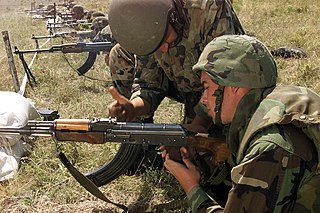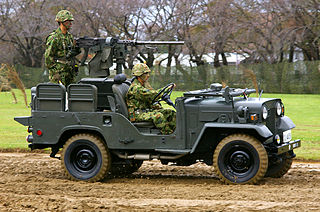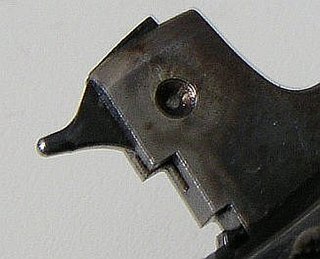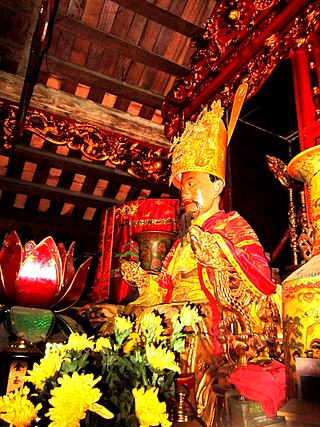Related Research Articles

An ambush is a surprise attack carried out by people lying in wait in a concealed position. The concealed position itself or the concealed person(s) may also be called an "ambush". Ambushes as a basic fighting tactic of soldiers or of criminals have been used consistently throughout history, from ancient to modern warfare.

A squad automatic weapon (SAW), also known as a section automatic weapon or light support weapon (LSW), is a man-portable automatic firearm attached to infantry squads or sections as a source of rapid direct firepower. Weapons fulfilling this role can be light machine guns, or modified selective-fire rifles fitted with a heavier barrel, bipod and a belt/drum-fed design.

A musket is a muzzle-loaded long gun that appeared as a smoothbore weapon in the early 16th century, at first as a heavier variant of the arquebus, capable of penetrating plate armour. By the mid-16th century, this type of musket gradually disappeared as the use of heavy armour declined, but musket continued as the generic term for smoothbore long guns until the mid-19th century. In turn, this style of musket was retired in the 19th century when rifled muskets using the Minié ball became common. The development of breech-loading firearms using self-contained cartridges and the first reliable repeating rifles produced by Winchester Repeating Arms Company in 1860 also led to their demise. By the time that repeating rifles became common, they were known as simply "rifles", ending the era of the musket.

Hit-and-run tactics are a tactical doctrine of using short surprise attacks, withdrawing before the enemy can respond in force, and constantly maneuvering to avoid full engagement with the enemy. The purpose is not to decisively defeat the enemy or capture territory but to weaken enemy forces over time through raids, harassment, and skirmishing and limiting risk to friendly forces. Such tactics can also expose enemy defensive weaknesses and achieve a psychological effect on the enemy's morale.

A booby trap is a device or setup that is intended to kill, harm or surprise a human or another animal. It is triggered by the presence or actions of the victim and sometimes has some form of bait designed to lure the victim towards it. The trap may be set to act upon trespassers that enter restricted areas, and it can be triggered when the victim performs an action. It can also be triggered by vehicles driving along a road, as in the case of improvised explosive devices (IEDs).

A firing pin or striker is a part of the firing mechanism of a firearm that impacts the primer in the base of a cartridge and causes it to fire. In firearms terminology, a striker is a particular type of firing pin where a compressed spring acts directly on the firing pin to provide the impact force rather than it being struck by a hammer.

The Fusil Modèle 1874 or Gras was the French Army's primary service rifle from 1874 to 1886. Designed by Colonel Basile Gras, the Gras was a metallic cartridge adaptation of the single-shot, breech-loading, black powder Chassepot rifle. It was developed from 1872 to 1874 as a response to the German adoption of the Mauser Model 1871 metallic cartridge rifle.

The 7.62×25mm Tokarev cartridge is a Soviet rimless bottleneck pistol cartridge widely used in former Soviet states and in China, among other countries. The cartridge has since been replaced in most capacities by the 9×18mm Makarov in Russian service.

The Škorpion vz. 61 is a Czechoslovak machine pistol developed in 1959 by Miroslav Rybář (1924–1970) and produced under the official designation Samopal vzor 61 by the Česká zbrojovka arms factory in Uherský Brod from 1963 to 1979. The standard version uses .32 ACP ammunition.

The Type 11 light machine gun was a light machine gun used by the Imperial Japanese Army in the interwar period and during World War II. Adopted as the Imperial Japanese Army's first light machine gun, the Type 11 was designed by Kijirō Nambu and had certain similarities to the Hotchkiss series of machine guns. It had an unusual feed system which required five round clips to be dropped into a hopper, this held up to a total of six clips and each round was oiled as it was fed into the chamber. Despite good overall performance, this feed system was prone to collect dirt and grit which would jam the weapon while in use. It was issued to troops in 1922 and saw extensive service as a squad weapon until 1945.

Operation Crimp, also known as the Battle of the Ho Bo Woods, was a joint US-Australian military operation during the Vietnam War, which took place 20 kilometres (12 mi) north of Cu Chi in Binh Duong Province, South Vietnam. The operation targeted a key Viet Cong headquarters that was believed to be concealed underground, and involved two brigades under the command of the US 1st Infantry Division, including the 1st Battalion, Royal Australian Regiment which was attached to the US 173rd Airborne Brigade. Heavy fighting resulted in significant casualties on both sides, but the combined American and Australian force was able to uncover an extensive tunnel network covering more than 200 kilometres, at the cost of 8 Australians and 14 Americans killed and 29 Australians and 76 Americans wounded.

The TM 31-210 Improvised Munitions Handbook is a 256 page United States Army technical manual intended for the United States Army Special Forces. It was first published in 1969 by the Department of the Army.

Cold vapour atomic fluorescence spectroscopy (CVAFS) is a subset of the analytical technique known as atomic fluorescence spectroscopy (AFS).

Henry Everett "Hank" Emerson was a United States Army lieutenant general best known for being the commander of the 2nd Infantry Division in South Korea during the mid-1970s, when Colin Powell served as a battalion commander. Emerson was a 1947 graduate of the United States Military Academy.

Ngô Quyền, often referred to as Tiền Ngô Vương, was a warlord who later became the founding king of the Ngô dynasty of Vietnam. He reigned from 939 to 944. In 938, he defeated the Southern Han dynasty at the Battle of Bạch Đằng River north of modern Haiphong. The battle is celebrated in Vietnamese national history as it ended 1,000 years of Chinese rule over Vietnam dating back to 111 BC under the Western Han dynasty. A central district in modern Haiphong is named after him.

VC and PAVN battle tactics comprised a flexible mix of guerrilla and conventional warfare battle tactics used by Viet Cong (VC) and the North Vietnamese People's Army of Vietnam (PAVN) to defeat their U.S. and South Vietnamese (GVN/ARVN) opponents during the Vietnam War.

The Battle of Suối Châu Pha was fought during the Vietnam War between Australian troops and the Việt Cộng. The battle took place during Operation Ballarat, an Australian search and destroy operation in the eastern Hát Dịch area, north-west of Núi Đất in Phước Tuy province. Following a covert insertion the day before which had caught a number of Việt Cộng sentries by surprise, A Company, 7th Battalion, Royal Australian Regiment had patrolled forward unaware of the presence of a large Việt Cộng main force unit nearby. Clashing with a reinforced company from the Việt Cộng 3rd Battalion, 274th Regiment, a classic encounter battle ensued between two forces of roughly equal size. Fought at close quarters in dense jungle amid a heavy monsoon rain, both sides suffered heavy casualties as neither was able to gain an advantage. Finally, after a battle lasting several hours, the Australian artillery proved decisive and the Việt Cộng were forced to withdraw, dragging many of their dead from the battlefield after having suffered crippling losses.
The action of 23 August 1967 was a major air battle which involved elements of the Vietnam People's Air Force (VPAF) and the United States Air Force (USAF). The air battle took place over the skies of North Vietnam as part of Operation Rolling Thunder, during the Vietnam War.
Operation John Paul Jones was an operation conducted by the 1st Brigade, 101st Airborne Division in Phú Yên Province, lasting from 21 July to 5 September 1966.

The Pistolet automatique modèle 1935A is a semi-automatic pistol designed by Charles Petter, chambered for the 7.65mm Longue cartridge. It was developed to compete in the 1935–1937 French military trials conducted by the Commission d’Experiences Techniques de Versailles to select a new sidearm.
References
- ↑ Lewis, Jon E., ed. (1997). "Tactics and Techniques, Personal Skills and Techniques". The Handbook of the SAS and Elite Forces: How the Professionals Fight and Win. Robinson Publishing. p. 337. ISBN 1-85487-675-9.